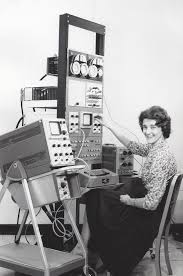Breaking Barriers: Celebrating Women in Science & Tech History
In celebration of Women's History Month and International Women's Day, it is important to take a moment to reflect on and honor the incredible...
4 min read
 GAM Tech Team
:
Mar 8, 2023 11:52:04 AM
GAM Tech Team
:
Mar 8, 2023 11:52:04 AM

Despite making up over half of the global population, women represent just 31.7% of researchers worldwide. This underrepresentation highlights the ongoing challenges women face in science, technology, engineering, and mathematics (STEM) fields.
Throughout history, women in science have battled societal barriers, limited access to education, and institutional bias to make some of the most groundbreaking discoveries in human history. Their work has transformed medicine, mathematics, space exploration, computing, and countless other fields, often without the recognition they deserve.
This blog honors 17 of the most notable women scientists from the past and present. From ancient pioneers to modern-day innovators, these female scientists changed the world and continue to inspire future generations.
(c. 360-415 AD)
One of the earliest recorded female scientists, Hypatia was a philosopher, astronomer, and mathematician in ancient Egypt. She taught at the Library of Alexandria and contributed to the development of algebra and astronomy during a time when women were rarely allowed to study, let alone teach. Hypatia's legacy lives on as a symbol of intellectual courage and scientific curiosity.
(1815-1852)
Often regarded as the first computer programmer, Ada Lovelace worked on Charles Babbage's Analytical Engine, a proposed mechanical computer. She wrote the first algorithm intended for machine processing and recognized that computers could manipulate symbols beyond arithmetic. Her work laid the foundation for modern programming.
(1867-1934)
Marie Curie broke multiple barriers as the first woman to win a Nobel Prize, and the only person to win in two different scientific fields, Physics and Chemistry. She discovered polonium and radium, and developed techniques for isolating radioactive isotopes. Her research was instrumental in the development of X-rays and cancer treatments. She remains one of the most famous female scientists in history.
(1918-2020)
Katherine Johnson was a trailblazing African American mathematician whose calculations were critical to the success of U.S. space missions, including John Glenn's orbital flight and the Apollo 11 moon landing. Working at NASA during segregation, she broke both racial and gender barriers. Her story reached millions through the film Hidden Figures.
(1912-1997)
A Chinese-American physicist, Chien-Shiung Wu worked on the Manhattan Project and later led the famous "Wu Experiment," which disproved the law of parity in physics. Although her male colleagues received a Nobel Prize for the discovery, Wu's work was central. She was later awarded the National Medal of Science and became a role model for women in physics.
(1920-1958)
Rosalind Franklin's X-ray diffraction images were critical in identifying the double-helix structure of DNA. Despite her pivotal role, her contributions were overlooked when the Nobel Prize was awarded to Watson, Crick, and Wilkins. Franklin's legacy as one of the most important women in science has only grown with time.
(1902-1992)
Barbara McClintock discovered genetic transposition, the ability of genes to change position on a chromosome. Initially met with skepticism, her findings were later confirmed and earned her the Nobel Prize in Physiology or Medicine in 1983. She remains a trailblazer in the field of genetics.
(1897-1984)
India's first female plant scientist, Janaki Ammal made major contributions to cytogenetics, plant breeding, and ethnobotany. Her work on sugarcane hybrids and native plant conservation helped shape India's agricultural future. Ammal also led the reorganization of the Botanical Survey of India and was awarded the Padma Shri for her service to science.
Modern Female Scientists Leading Innovation
(1951- )
Often called the "Mother of the Internet," Radia Perlman is a computer scientist who developed the Spanning Tree Protocol, a critical innovation in network architecture. Her work made Ethernet networks scalable and reliable. She also pioneered educational programming tools for children. Perlman's contributions remain fundamental to modern internet technology.
10. Jennifer Doudna - CRISPR and Genetic Editing
(1964- )
Jennifer Doudna is a biochemist known for co-developing CRISPR-Cas9, a revolutionary gene-editing technology that allows precise edits to DNA. Her work has opened new possibilities in treating genetic disorders. She was awarded the Nobel Prize in Chemistry in 2020 and continues to shape the future of medicine and biology.
(1930- )
Dr. Gladys West is a mathematician whose calculations of the Earth's shape were essential to the development of GPS technology. Working for the U.S. Navy, her research on satellite data and geodesy provided the mathematical modeling that powers today's navigation systems. In 2018, she was inducted into the U.S. Air Force Hall of Fame.
(1971- )
An MIT astrophysicist, Sara Seager has contributed to the discovery of over 700 exoplanets. Her research explores atmospheres of planets outside our solar system, helping scientists search for potentially habitable worlds. Seager is a leading figure in modern astronomy and exoplanet science.
(1934- )
Jane Goodall revolutionized primate research with her work on chimpanzees in Tanzania. Her decades-long field studies transformed our understanding of animal behavior and cognition. Goodall is also a leading voice in environmental conservation and animal rights.
(1907-1964)
Rachel Carson's book Silent Spring exposed the dangers of pesticide use and sparked the modern environmental movement. A marine biologist and writer, Carson faced intense backlash from chemical companies but helped lead to policy changes and the creation of the U.S. Environmental Protection Agency.
(1947-2020)
Flossie Wong-Staal was the first scientist to clone HIV and map its genes, enabling the development of the first diagnostic tests for the virus. Her research was essential to understanding and fighting the AIDS epidemic. Wong-Staal's career also included advances in gene therapy and cancer research.
(1956- )
Mae Jemison was the first African American woman in space, flying aboard the Space Shuttle Endeavour in 1992. A medical doctor, engineer, and former Peace Corps volunteer, Jemison's career bridges science, space, and global health. She continues to advocate for STEM education and diversity in science.
(1928-2016)
Vera Rubin's research provided the first direct evidence of dark matter. Her observations of galaxy rotation revealed that visible matter alone could not explain gravitational forces. Despite being overlooked by the Nobel Committee, Rubin received the National Medal of Science and left a lasting legacy in astrophysics.
The contributions of these 17 female scientists span centuries and disciplines, yet many of their stories were untold or undervalued during their lifetimes. Their achievements remind us that scientific brilliance exists across all genders and backgrounds.
Encouraging more girls and young women to pursue careers in science, technology, engineering, and math means building on the legacy of these pioneers. With access to education, resources, and mentorship, the next generation of women scientists is already shaping the world of tomorrow.

In celebration of Women's History Month and International Women's Day, it is important to take a moment to reflect on and honor the incredible...
 Learn more about our Managed IT Services
Learn more about our Managed IT Services

3 min read
Wi-Fi does not kill plants. Home Wi-Fi signals are non-ionizing and operate at power levels far below recognized safety limits. Studies have not...